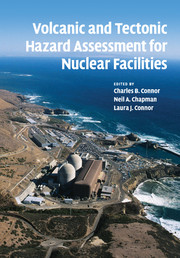Book contents
- Frontmatter
- Contents
- List of contributors
- Preface
- 1 Tectonic events and nuclear facilities
- 2 The nature of tectonic hazards
- 3 The nature of volcanism
- 4 Tectonic uplift and subsidence
- 5 Glacial isostatic adjustment: implications for glacially induced faulting and nuclear waste repositories
- 6 Using global positioning system data to assess tectonic hazards
- 7 Tectonic setting of volcanic centers in subduction zones: three-dimensional structure of mantle wedge and arc crust
- 8 Conceptual model for small-volume alkali basalt petrogenesis: implications for volcanic hazards at the proposed Yucca Mountain nuclear waste repository
- 9 Aspects of volcanic hazard assessment for the Bataan nuclear power plant, Luzon Peninsula, Philippines
- 10 Multi-disciplinary probabilistic tectonic hazard analysis
- 11 Tsunami hazard assessment
- 12 Regional-scale volcanology in support of site-specific investigations
- 13 Exploring long-term hazards using a Quaternary volcano database
- 14 Estimating spatial density with kernel methods
- 15 Cox process models for the estimation of long-term volcanic hazard
- 16 Spatial distribution of eruptive centers about the Idaho National Laboratory
- 17 Modeling the flow of basaltic magma into subsurface nuclear facilities
- 18 Intrusion dynamics for volatile-poor basaltic magma into subsurface nuclear installations
- 19 Volcanic risk assessment at Yucca Mountain, NV, USA: integration of geophysics, geology and modeling
- 20 Geological issues in practice: experience in siting US nuclear facilities
- 21 Characterizing active tectonic structures for nuclear facilities in Japan
- 22 Issues for coastal sites
- 23 Stable tectonic settings: designing site investigations to establish the tectonic basis for design and safety evaluation of geological repositories in Scandinavia
- 24 The impact of subsidence, uplift and erosion on geological repositories for radioactive wastes
- 25 Recommendations for assessing volcanic hazards at sites of nuclear installations
- 26 Formal expert assessment in probabilistic seismic and volcanic hazard analysis
- Index
- Map
23 - Stable tectonic settings: designing site investigations to establish the tectonic basis for design and safety evaluation of geological repositories in Scandinavia
Published online by Cambridge University Press: 27 May 2010
- Frontmatter
- Contents
- List of contributors
- Preface
- 1 Tectonic events and nuclear facilities
- 2 The nature of tectonic hazards
- 3 The nature of volcanism
- 4 Tectonic uplift and subsidence
- 5 Glacial isostatic adjustment: implications for glacially induced faulting and nuclear waste repositories
- 6 Using global positioning system data to assess tectonic hazards
- 7 Tectonic setting of volcanic centers in subduction zones: three-dimensional structure of mantle wedge and arc crust
- 8 Conceptual model for small-volume alkali basalt petrogenesis: implications for volcanic hazards at the proposed Yucca Mountain nuclear waste repository
- 9 Aspects of volcanic hazard assessment for the Bataan nuclear power plant, Luzon Peninsula, Philippines
- 10 Multi-disciplinary probabilistic tectonic hazard analysis
- 11 Tsunami hazard assessment
- 12 Regional-scale volcanology in support of site-specific investigations
- 13 Exploring long-term hazards using a Quaternary volcano database
- 14 Estimating spatial density with kernel methods
- 15 Cox process models for the estimation of long-term volcanic hazard
- 16 Spatial distribution of eruptive centers about the Idaho National Laboratory
- 17 Modeling the flow of basaltic magma into subsurface nuclear facilities
- 18 Intrusion dynamics for volatile-poor basaltic magma into subsurface nuclear installations
- 19 Volcanic risk assessment at Yucca Mountain, NV, USA: integration of geophysics, geology and modeling
- 20 Geological issues in practice: experience in siting US nuclear facilities
- 21 Characterizing active tectonic structures for nuclear facilities in Japan
- 22 Issues for coastal sites
- 23 Stable tectonic settings: designing site investigations to establish the tectonic basis for design and safety evaluation of geological repositories in Scandinavia
- 24 The impact of subsidence, uplift and erosion on geological repositories for radioactive wastes
- 25 Recommendations for assessing volcanic hazards at sites of nuclear installations
- 26 Formal expert assessment in probabilistic seismic and volcanic hazard analysis
- Index
- Map
Summary
Knowledge of the tectonic setting of the site for a nuclear facility is required in order to develop a design for the facility and to evaluate its safety, both during its operational phase and, in the case of a radioactive waste repository, following its closure. Understanding the tectonic evolution of the site and of the area in which it lies permits estimation of, for example, future seismic or volcanic activity. In this chapter, we focus specifically on the investigation of sites proposed for deep geological repositories for radioactive waste, although the structured approach and many of the general principles discussed are more widely applicable to the siting of other nuclear facilities. This chapter also focuses on the situation of a relatively stable tectonic environment, which exists in much of Scandinavia, where volcanic activity is not a consideration and where the maximum level of seismic activity is low, at least as far into the future as the next glaciation. Olkiluoto, in Finland, is used as an example of such a stable tectonic environment to illustrate the approach that is being taken in its characterization. Neotectonic activity is still of interest, however, in a Scandinavian context, and reference is also made to the situation of sites in less tectonically stable environments.
An understanding of the tectonic setting of a site, even where the tectonic activity is relatively benign, is an integral part of developing an understanding of the overall geological environment, so that a convincing and well-founded geological model of the site can be developed.
- Type
- Chapter
- Information
- Volcanic and Tectonic Hazard Assessment for Nuclear Facilities , pp. 527 - 547Publisher: Cambridge University PressPrint publication year: 2009

